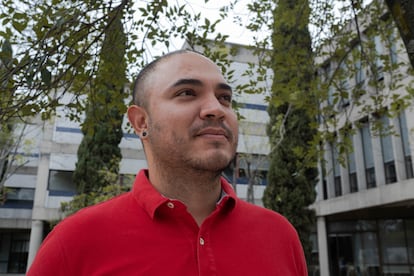Mexican criminologist Tadeo Luna: ‘Lynchings are often attributed to indigenous traditions, but now they are more related to inequality in the cities’
In Mexico, these types of murders by angry crowds are spreading from rural to urban areas and are frequently incited by organized crime


In mid-April, a mob lynched a destitute man in Mexico because he was caught stealing from a field of broccoli. He was starving, said the Puebla (Mexico) prosecutor, but the community took matters into its own hands. The poor man died in the hospital. Lynchings have been on the rise in Mexico since 2015, with a brief hiatus during the pandemic. These killings are usually blamed on rampant impunity and ancestral traditions in rural areas where the government and law enforcement have little reach. But the reality is that mob lynchings are no longer confined to rural zones.
Tadeo Luna, a criminologist at the Ibero-American University of Puebla, has studied the problem and identified other causes and motivations. Luna says neoliberal policies have scaled back security and justice functions in government and relegated responsibility to the citizenry. He also says toxic masculinity leads to violence under the pretext of protecting vulnerable women and families. The government lacks the will to stop these gruesome murders, which have spread from rural to urban areas, and now organized crime — the scourge of Mexico — is inciting mob violence to further their illegal interests.
Question. There are no official statistics on lynchings in Mexico, but you say they are increasing exponentially. Why?
Answer. It’s a historical form of violent justice that, since 2006, now has a criminal element. One consequence of the so-called war on drugs has been the democratization of violence. Besides the government and the police, organized crime now has the legitimacy of exercising violence. The public is caught in the middle of these two forces and compensates for its feeling of insecurity with violence.
Q. You have documented evidence that these are not always spontaneous killings committed in the heat of the moment.
A. We have evidence that many have been orchestrated or incited by organized crime. For example, prosecutors now know the 2016 census worker murders were ordered by a crime boss who mistook them for the intended target. These are not isolated cases — organized crime is directly responsible for many of them.
Q. Are there more lynchings in certain parts of the country like Puebla?
A. They seem to be concentrated in central Mexico and in the south, but we don’t know why. Lynchings are often attributed to indigenous traditions, but not anymore. Now they are more related to inequality in the cities, and many lynchings are happening in urban areas. But in rural mountain areas, they have less to do with poverty and more with communities that are tired of the government’s neglect of their needs for security and justice. And more and more lynchings are occurring in places you wouldn’t imagine, like the Monterrey metropolitan area in the north.
Q. But is that feeling of insecurity warranted? These are often towns without much crime and the victims weren’t criminals in most cases.
A. It’s like the straw that broke the camel’s back. Lynchings happen because communities are so fed up and suddenly erupt. Structural violence is a key element in this. People cannot verbalize their anger about poverty because they have normalized it. Government violence is another example. Look how difficult it is to file a complaint, or how police demand money to arrest an offender only to release him later… These things build up and incidents like the broccoli theft are just a pretext. The nature of the alleged offender also fulfills a very important social function: we are afraid of rapists, but not of climate change and not of running out of money. Putting a name and face to the threat makes other problems smaller.
Q. Do people turn a blind eye as a defensive mechanism against all the other evils that afflict them?
A. Media and government rhetoric try to push us in that direction. The war on drugs uses this strategy: narcos are the bad guys and must be brought down. The narcos are what’s wrong with the country, not the economy. Families don’t necessarily experience this, but they hear it so often that they’re convinced insecurity is the main problem. They shift the spotlight. Lynchings orient the violence in a convenient direction for law enforcement and the government.
Q. But it’s very common now.
A. If the citizenry exercises collective violence to maintain the status quo, the government wins because it doesn’t have to deal with violence that demands rights and security, or protests calling for justice, security and well-being. The people who are lynched and those doing the lynching belong to a lower socio-economic class. They do the government’s work and demand nothing in return.
Q. Does the government just let it happen and look the other way?
A. Exactly. The last few municipal governments here in Puebla have implemented community-based crime prevention policies. They have programs called “safe community and neighborhood watch,” or something like that. Neoliberal policies have eroded certain government functions. Some of the few that remained intact were security and the administration of justice, but not even that anymore. It’s a neoliberal process with consequences. It begins with private security forces performing public security functions, followed by the privatization of the justice system.
Q. So government neglect isn’t just a historical reality, but a current, intentional and convenient government policy.
A. Of course. They have ceded public security to the citizenry, and not just to the lynch mobs. If you’re afraid of violence and have the financial means, you move to a private condominium, hire security guards and buy an armored car. But if you don’t have the resources, maybe you make do with sticks and stones. This isn’t a justification, just an explanation.
Q. Surveys in Mexico reveal a high tolerance for taking the law into one’s own hands. Seventy percent of the people polled think it’s okay to deal with crime in this manner.
A. I think that has to do with the impunity we all know about. Lynchings go unpunished – how many people have been convicted for this?
Q. Who is getting lynched? Outsiders or people from the community itself?
A. We don’t have precise data on this. There are cases where people from nearby communities are lynched, but it’s usually an outsider. But we know that, in most communities, the purported goal isn’t fulfilled because people don’t feel safer after a lynching.
Q. Nor do they feel guilty about it.
A. Right.
Q. The lynchings seem to be somewhat ritualistic — you can see it in the videos. It’s as if they had a protocol, like when they celebrate the community’s patron saint. First beatings, then fire.
A. Those rituals are more common in rural communities, but not so much in the cities. We don’t know the origin of the ritual. It seems more like something people learned from television. They always take them [the offenders] to the town center. And sometimes when the police intervene and make an arrest, the mob pulls them out of jail to teach them a lesson. Lynch mobs just want to take out their anger on someone and not necessarily on the guilty party. They want someone to pay for all their frustrations.
Q. Who is doing the killing? Men? Is this a macho thing?
A. Oh, boy. I think so — like all forms of violence, generally speaking. Both the lynchers and the lynched are men. There is a macho ethos that shuns killing women. When a man and a woman are arrested together, people will say that the woman was just accompanying him. Fear is usually associated with the male sex, and masculinity makes us believe that a woman can’t be a criminal. When people are arrested for a lynching, the women are accused of spreading the malicious rumor and the men for committing the violence. Gender roles, again.
Q. Back to government neglect. Sometimes mayors and municipal judges take part in lynchings, perhaps to assert authority.
A. Possibly, yes. But mostly it’s about masculinity. Many of the lynchings are on public roads for nothing more than theft. But a good many lynchings are driven by misguided notions about protecting women, families and communities. Lots of them are people accused of kidnapping.
Q. Medieval honor.
A. Of course. Lynching asserts masculinity. The alleged victims of the incidents that trigger lynchings are usually women and children.
Q. Governments also say nothing about certain crimes, as if they didn’t want to re-victimize the people they have abandoned.
A. I don’t know if this is because of some paternalistic idea about not disciplining the people they have abandoned, or because it’s just convenient for them. Convenient because the community is doing the government’s work by killing people it should be arresting, all because it doesn’t have the wherewithal to provide public security.
Q. When will this end?
A. I don’t know, but I’m not optimistic.
Sign up for our weekly newsletter to get more English-language news coverage from EL PAÍS USA Edition
Tu suscripción se está usando en otro dispositivo
¿Quieres añadir otro usuario a tu suscripción?
Si continúas leyendo en este dispositivo, no se podrá leer en el otro.
FlechaTu suscripción se está usando en otro dispositivo y solo puedes acceder a EL PAÍS desde un dispositivo a la vez.
Si quieres compartir tu cuenta, cambia tu suscripción a la modalidad Premium, así podrás añadir otro usuario. Cada uno accederá con su propia cuenta de email, lo que os permitirá personalizar vuestra experiencia en EL PAÍS.
¿Tienes una suscripción de empresa? Accede aquí para contratar más cuentas.
En el caso de no saber quién está usando tu cuenta, te recomendamos cambiar tu contraseña aquí.
Si decides continuar compartiendo tu cuenta, este mensaje se mostrará en tu dispositivo y en el de la otra persona que está usando tu cuenta de forma indefinida, afectando a tu experiencia de lectura. Puedes consultar aquí los términos y condiciones de la suscripción digital.
More information
Archived In
Últimas noticias
Welcome to the post-religion era: The idea of Christianity as the absolute truth has become obsolete
‘I thought you would like it’: The risky sexual practice popularized by TV shows and TikTok
The digitalization of tourism: ‘They promise experiences and gave us the worst possible one’
Mexican peso defies uncertainty with forecasts of a new period of stability in 2026
Most viewed
- Sinaloa Cartel war is taking its toll on Los Chapitos
- Oona Chaplin: ‘I told James Cameron that I was living in a treehouse and starting a permaculture project with a friend’
- Reinhard Genzel, Nobel laureate in physics: ‘One-minute videos will never give you the truth’
- Why the price of coffee has skyrocketed: from Brazilian plantations to specialty coffee houses
- Silver prices are going crazy: This is what’s fueling the rally










































